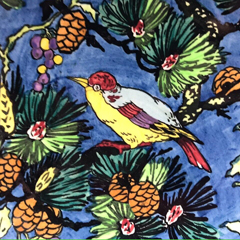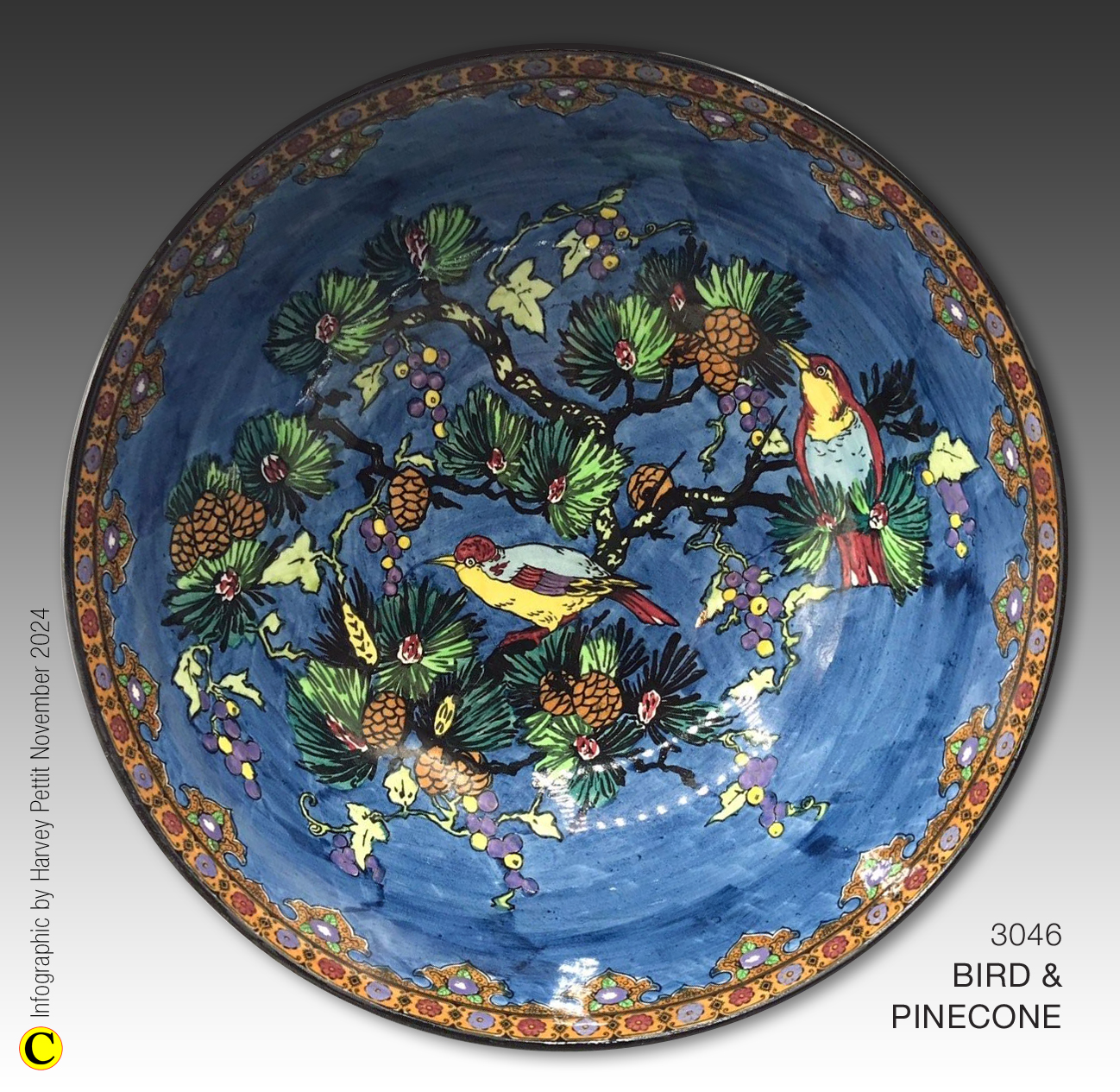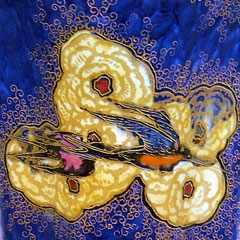Boulton's Birds - Part Seven

The BIRD & PINECONE pattern
Devised by Enoch Boulton
by Harvey Pettitwith border artwork by Barbara Anne Lee
This is the seventh in a series of sixteen articles on bird patterns introduced by Enoch Boulton during his tenure as designer and decorating manager at the Carlton Works from 1921/22 to 1930.
Unlike Carlton Ware's PARROT pattern with its astonishing twenty-seven variants, discussed in the previous article, BIRD & PINECONE had only two. Both were printed in black. The first, 3047, which has a BLUE ground, and is shown below, departs from using the more usual uniform, even grounds, that were either aerographed or groundlayed, a labour-intensive and thus expensive technique. Instead, the obvious brush strokes on examples tell us that the ground was handpainted.

To view this bowl fit your device's screen and/or enlarge, click or tap on it.
To return to this page use your back button.
Typically, for this type of decoration, the area occupied by the underglaze-painted pattern was masked from the BLUE ground by painting over it with slip (liquid clay). Once the watery slip had dried, the oil-based ground colour was applied, and the slip was washed off. Since oil and water do not mix, the ground colour remained. Without masking, the other colours used to paint the pattern would have been muted and much less bright. By clicking or tapping on the image above and then clicking or tapping again, you can magnify it to see the masking more clearly.
According to Carlton Ware's records, the other of the two variants was allocated the pattern number 3051, so it was introduced at the same time as its counterpart. It too was underglaze painted but had a stippled ORANGE ground. Unfortunately, I don't have an example to show you.
Borders used with BIRD & PINECONE
A border was not designed specifically for BIRD & PINECONE. Instead, the version with the handpainted BLUE ground, 3046, used the one devised for Carlton Ware's TURKISH pattern and printed in black against what the pottery or their colour supplier called a BUFF ground. TURKISH was also by Enoch Boulton and introduced in the same year. Barb has redrawn the border for us below.

Pattern records tell us the version with the stippled ORANGE ground, 3051, uses MAGPIE BORDER, which Barb has also redrawn with an excellent simulation of stippling. You can enlarge this simulation by clicking on it.

Date
Since few dates are given in Carlton Ware's surviving records, it is not always easy to establish the date of introduction of patterns or shapes. However, I estimate that Bird & Pinecone was launched in late 1925 or early 1926.
Availability
As with the PARROT pattern, introduced at the same time, I do not know how long BIRD & PINECONE was available. I suggest that it may only have been for a year or two. A clue leading to this reasoning is that, to date, I have not seen an example of the pattern with Carlton Ware's Script backstamp (also the Pottery's registered trademark), which was in use from 1926 onwards.
As I have mentioned before, Carlton Ware's continuing success depended on a constant stream of new patterns to offer their customers. Consequently, older patterns and ranges would be discontinued to make way for new ones. If a pattern, or indeed a shape, did not sell well, this would accelerate its cessation. As always, there are exceptions to cancellations.
The next pattern in this series of articles will be on Carlton Ware's SWALLOW & CLOUD pattern.
V1 November 2024.
If more accurate information comes to light I will update this page.
Barb would like to thank the members of our companion Facebook Group, who supplied good quality images to help her replicate the borders above.

